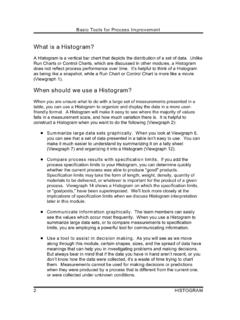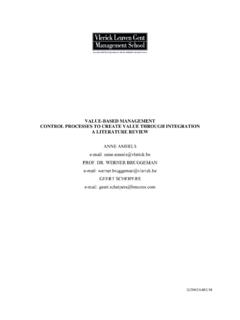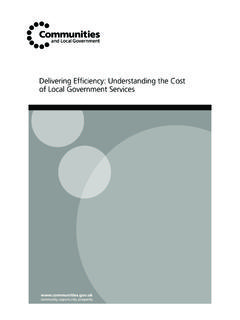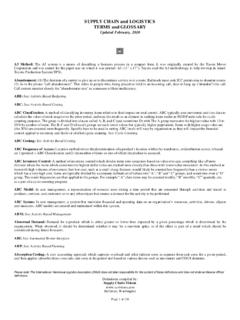Transcription of The basics of Activity Based Management - SaferPak.com
1 The basics of Activity Based Management The battle to sustain and increase corporate profitability grows ever more arduous in most sectors of the economy. Margins are caught in a pincer movement by, on the one hand, the steady improvement in competition, and on the other, the increasing awareness of customers. We need to grasp every opportunity not only to be ever more effective at what we do, but also to be truly competitive, winning more market share of the customers both nationally and globally. For success, a full understanding of costs and cost structures is necessary.
2 Conventional accounting and Management reporting throw little light on the real cost dynamics in a business. As a result we are not in control of profitability at a level of detail that supports substantive decision-making. Activity Based Management (ABM) is an approach that has now come of age. ABM is not a technique; it is about Management . ABM needs to be understood and implemented by all functions so its power can be unleashed and the benefits obtained. Over time, ABM has evolved considerably and is now being applied in manufacturing, service companies, utilities, logistics, telecommunications, government bodies and many more sectors.
3 With ABM; businesses can make dramatic improvements in measuring product and process costs, and more importantly customer profitability. On its own, ABM help will change Management decision-making. By understanding how ABM also supports other profit improvement initiatives such as Business Process Re-engineering, Shareholder Value Added and Customer Relationship Management , managers will learn how they can have the best possible toolkit to help put the business firmly on the road to leaps in profitability. Activity Based Management Activity Based Management (ABM) enables managers to understand product and customer profitability, the cost of business processes, and how to improve them.
4 Since conventional Management accounts and standard costing systems do not provide this information, it is perhaps surprising that ABM is not more widely used. Unlike many Management techniques, research shows that 80 per cent of companies that have employed Activity - Based techniques found them to be successful. Why? Activities consume resources people, materials and equipment and this consumption can be measured. Activities are triggered by events, which can be counted, or decisions, which can be reviewed. Activities produce outputs products and services, which can be counted and measured.
5 Activities can be undertaken by different methods, which will vary the unit cost. Activities are linked together to form business processes. Understanding what activities are, what they cost, what drives them, what they produce, how they are done and how they are linked together is useful. We have understood manufacturing activities in this way for years. We measure the consumption of direct labour and materials in making products. On average, however, direct labour, materials and components account for around two thirds of total costs in manufacturing businesses.
6 The other, unmeasured, third is overhead activities and costs. In service industries, the ratio is the other way round the unmeasured overhead accounts for two-thirds or more of costs. Overhead costs are the black hole in conventional Management information systems. ABM shines light into the hole. Knowledge of a business at the level of activities is the basic building block upon which new understanding can be built of where profits are being made and where they are being eroded. By making visible what was previously invisible, ABM throws a spotlight on those aspects of a business where action can directly improve business performance.
7 Because it deals with financial numbers , ABM is often seen as the preserve of the Finance function. In fact, its real strength lies in providing genuinely useful information for all functions in an organisation. Managers throughout the business need the right information to understand and address two key issues: How the company can position itself better in the market for which accurate product and customer profitability information is vital. How it can improve its internal capability and lower unit costs for this, it needs to understand and change the procedures, systems and processes that create products and deliver services to customers.
8 Most organisations are complex. Building an ABM model of a business requires a structured approach and the dedication of a team to achieve a result in a reasonable timescale. But building a model is only the start. Embedding ABM into the business means giving managers not only a new understanding of what drives costs, but the means to measure and act on the drivers to reverse adverse trends. Initially Activity Based Costing (ABC) was presented as a means of establishing product costs more accurately. The emergence of Activity Based Management (ABM) provided a means of enhancing profitability.
9 ABM is underpinned by a theory of resource consumption with activities viewed as giving rise to costs, as in ABC, but taking the analysis further in a way that provides Management with insights into managing the business overall. Essentially, these insights are focused on a process view of the business and a deeper understanding of product, channel and customer profitability. Costing and profitability The ledger, budgeting and monthly Management accounts are Based on reporting resources; those planned to be used, the consumption month on month and the variances from plan Resources are those things that provide the means so work can be done in the organisation.
10 Salary costs for the people doing the work, accommodation costs so people can work in buildings, utilities so people can see what they are doing and keep warm, vehicles so goods can be delivered and customers visited. In some cases, the list of types of resources on the ledger may seem endless. But no matter how long the list of resources, nothing in the ledger or the Management accounts tells us how the resources are being consumed on doing things, to what purpose or in what way. Resources are consumed by activities and it is at this level of analysis that we see what is actually being done.











